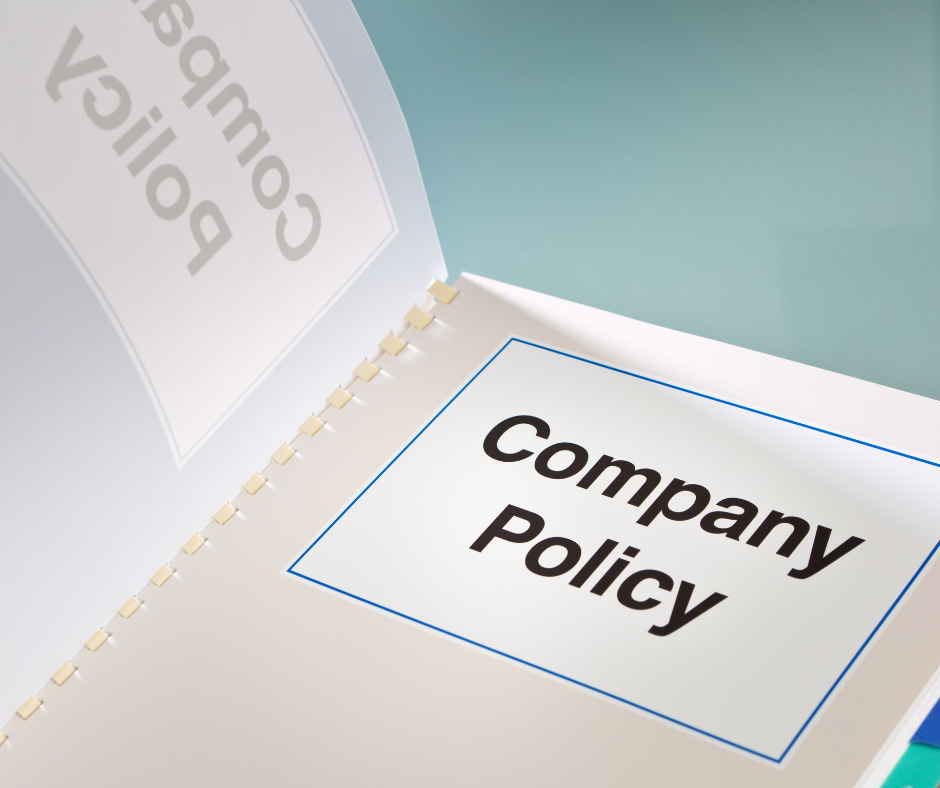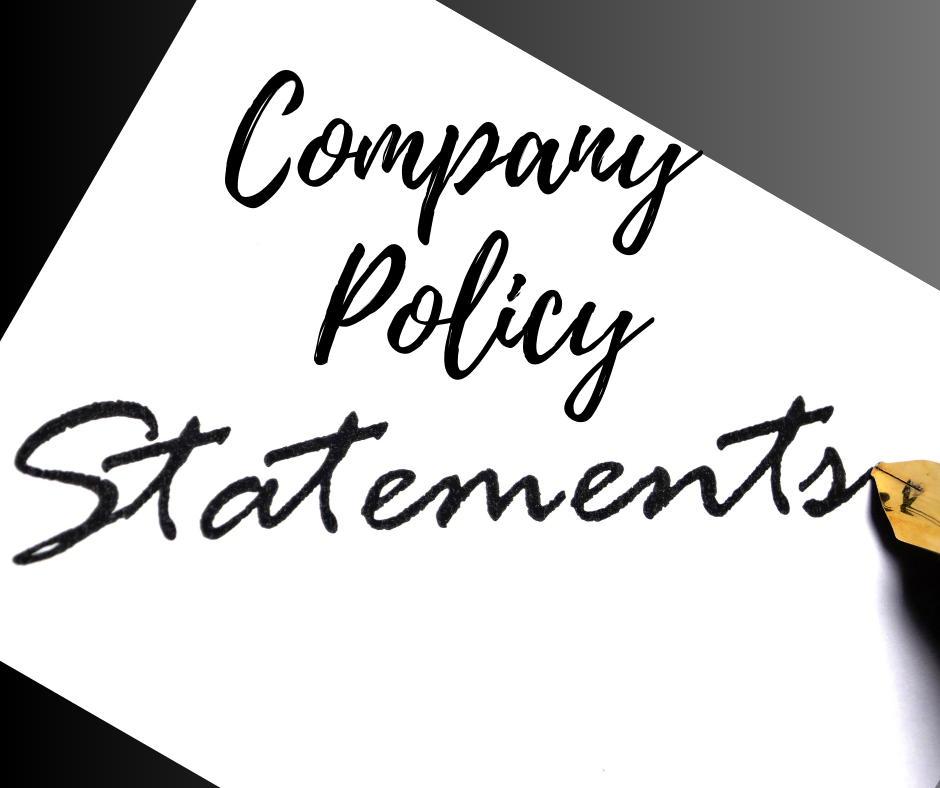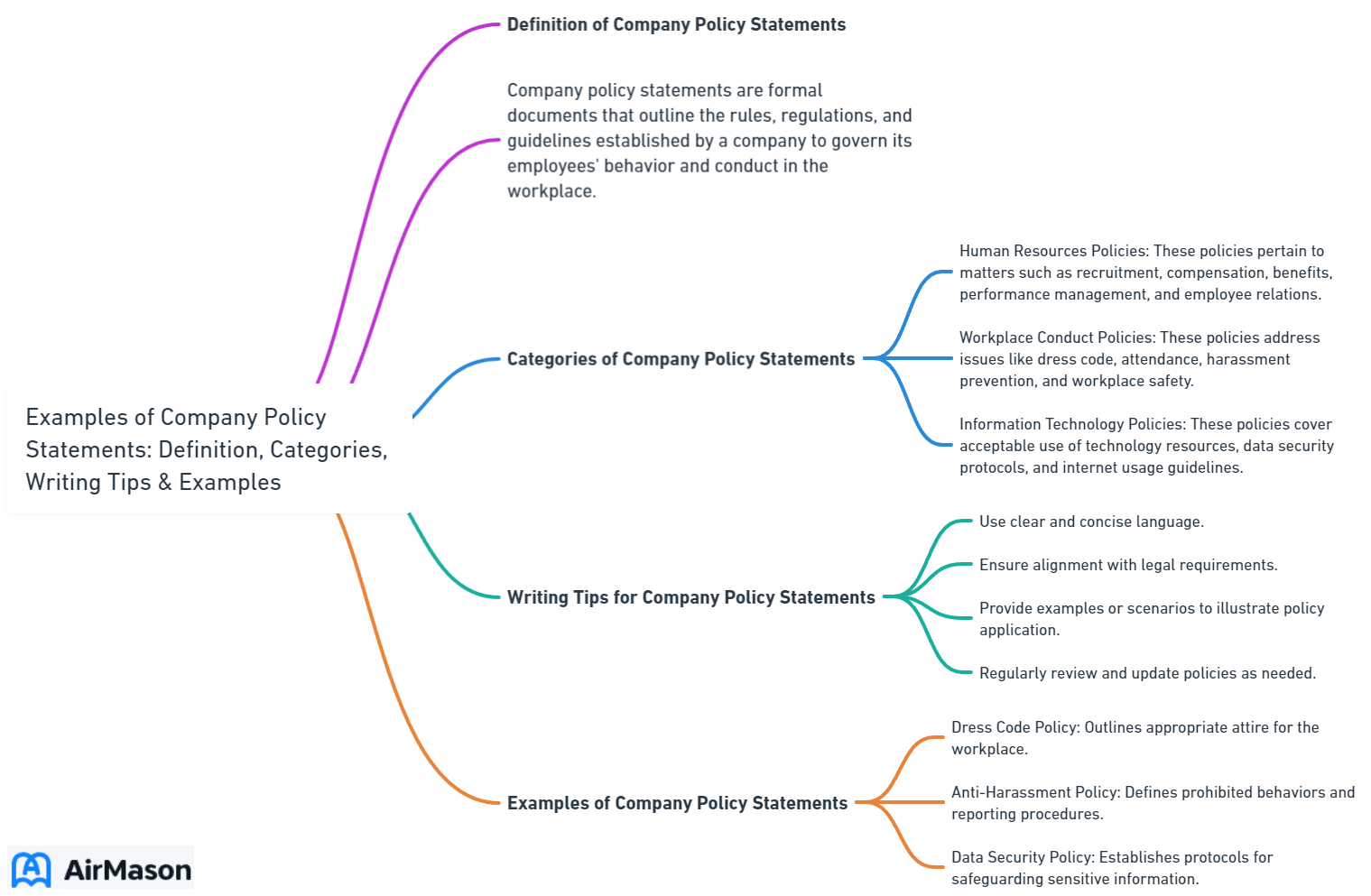
In the world of business, policy statements serve as the backbone of a company, guiding employee behavior and ensuring compliance with legal rules and regulations. A well-crafted policy statement not only sets the tone for a company’s culture, but also contributes to its success. So, how do you create effective policy statements that employees can easily understand and follow? This blog post will shed light on this crucial aspect of company management, providing you with the knowledge and tools necessary to establish a strong foundation for your organization, including examples of company policy statements.
Key Takeaways
- Policy statements are written guidelines that outline a company’s rules and regulations to ensure compliance with legal requirements.
- Key elements of policy statements include title, purpose, scope, definitions and responsibilities.
- Policy statement writing involves assessing assets, conducting business impact analysis and seeking professional advice for effective implementation.
Understanding Policy Statements
Policy statements, serving as conduct policy documents, are written guidelines that delineate a company’s rules and regulations. They aim to provide directions for employee conduct and ensure compliance with legal rules and regulations.
An effective policy statement should be clear, concise, specific enough to provide guidance without being prescriptive, realistic, and achievable, as it outlines what employees should follow. Examples of effective policy statements include mandating antivirus protection on all computers, restricting server configurations to designated functions, and necessitating formal approval for data access, which can influence personal behavior in the workplace.
Defining Policy Statements
A policy statement, which can be included in an employee handbook, is a document at the organizational level outlining acceptable methods or behaviors. It provides guidance to the organization in a particular direction, distinct from procedures and standard operating procedures, and can be part of an employee code of conduct.
The most frequent error when delineating the parameters of a policy statement is presuming that it is applicable to all persons when, in reality, most organizations have a considerable number of contractors providing services. In much the same way, the crafting of academic works often relies on support services such as akademisches ghostwriting, which assists in maintaining standards of quality and compliance. The primary document that regulates what is and is not applicable to those contractors is the contract and service level agreement, which identifies the person responsible for compliance.
Types of Policy Statements
Policy statements are of many types. These include:
- Human resources policies
- Financial policies
- Legal/regulatory policies
- Safety policies
- Operational policies
Specific policies, like security policies, are tailored to the needs of a particular organization, while general policies represent the overarching philosophies of management and do not have a significant influence on employee performance plans.
Financial policy statements pertain to an organization’s finances, while functional policies serve various objectives depending on the industry they serve, facilitating coordination between different departments and personnel.
The human resources policy statements of any organization serve to express its intentions, objectives or goals with respect to its human resources. They provide a framework by which these goals can be pursued and monitored. Organizational policies cover the overall organizational charts hierarchy, originated policies stem from managerial positions, and imposed policies are given by external factors to a company, such as government agencies or trade unions.
Creating Effective Company Policy Statements
The formulation of policy statements necessitates an assessment of the company’s assets, including intellectual property, and a business impact analysis to determine the extent of control imposed in the policy. Identifying the relevant company policy details is the initial step in composing a policy statement.
Promoting a unified and professional image of the organization, a standardized structure across all policies ensures clarity and ease of navigation for employees and clients.
Key Elements of Policy Statements
The essential components of a policy statement include:
- Title
- Purpose
- Scope
- Definitions
- Policy statement
- Responsibilities
- Procedures
- Compliance and enforcement
- Review and revision
- Effective date
For example, a policy statement on attendance might include:
- Title: “Attendance Policy”
- Purpose: “To ensure that employees are punctual and reliable”. All employees are subject to this policy. Compliance is mandatory.
- Definitions: “Absence: any period of time when an employee is not present at work”
- Policy Statement: “Employees are expected to be punctual and reliable”
- Responsibilities: “Employees are responsible for arriving to work on time”
- Procedures: “Employees must notify their supervisor if they are going to be late”
- Compliance and Enforcement: “Employees who are late will be subject to disciplinary action”
- Review and Revision: “This policy will be reviewed annually”
- Effective Date:

Writing Tips for Policy Statements
The composition of an effective policy statement requires defining the purpose, scope, and guidelines, involving employees, and seeking legal advice. Employees can be included in the policy statement writing process by offering feedback and proposals concerning the policy statement.
To guarantee the legality of a policy statement, ensure that the policy is compliant with all applicable laws and regulations, and consult a legal specialist if necessary. Provide employees with plain, professional language that clearly articulates the intended objectives and outlines the necessary steps for compliance.
Examples of Common Company Policy Statements
Company policy statements serve to:
- Create a transparent set of expectations for company employees
- Guarantee that all parties are aware of the same information
- Safeguard the company from potential legal implications
- Provide an outline for resolving conflicts.
Some examples of company policy statements, such as policy statement examples, include anti-discrimination policy, code of conduct, social media policy, dress code policy, and attendance policy.
Attendance Policy
An attendance policy regulates the employee’s attendance at work and delineates the measures to be taken in the event of:
- Tardiness
- Non-attendance
- Premature departures
- Other violations of the policy
The policy is applicable to all personnel regardless of their role or kind of employment.
The intent of the attendance policy is to guarantee consistent attendance and timeliness of personnel to avert any aberrations that could lead to reduced efficiency. Dismissal without prior notification is the consequence for job abandonment.
Writing an attendance policy for your small business? Read our article on small business company policy template to help you get started!
Equal Opportunity Policy
The equal opportunity policy is set in place to ensure that each job applicant and employee is treated fairly regardless of their:
- age
- color
- gender
- national origin
- race
- religion
It does not permit any discrimination based on these factors. The Equal Opportunity Officer is charged with implementing and overseeing equal opportunity practices in the organization.
An equal opportunity policy assists in establishing a workplace atmosphere that is devoid of discrimination and grants equal access to:
- Employment
- Training
- Promotion
- Other advantages
This policy also assists in constructing a varied and inclusive workplace where everyone has an equal opportunity to succeed.

Workplace Health and Safety Policy
A workplace health and safety policy is a written statement that outlines an organization’s commitment to ensuring a safe and healthy work environment for its employees. It encompasses:
- Guidelines
- Procedures
- Responsibilities for sustaining workplace safety
- Averting accidents and injuries
- Fostering employee well-being.
The employer is fully accountable for guaranteeing the security of every company employee and client in the workspace. Management has an important role to play in preventing workplace incidents. They must ensure that safety program initiatives are carried out and sustained.
Information Security Policy
An information security policy is a set of guidelines and rules that outline how an organization will protect its information assets. It defines the objectives, responsibilities, and procedures for ensuring the confidentiality, integrity, and availability of information. The policy typically covers areas such as:
- Data classification
- Access control
- Incident response
- Employee responsibilities
It serves to establish a framework for managing and mitigating information security risks within an organization.
Implementing and Reviewing Company Policy Statements
Implementing a policy statement involves the following steps:
- Defining the policy statement
- Developing the policy
- Communicating the policy
- Training employees
- Monitoring compliance
- Reviewing and updating the policy
Ensuring that all personnel are informed about the policy and understand it is fundamental. This can be achieved through emails, meetings, or other forms of communication.
A well-structured policy outline serves as the foundation for effective policy management within an organization. However, creating a policy outline is just the initial step in the process. To gain further insights into crafting a comprehensive and effective policy outline, we encourage you to read our article on policy outline examples. This resource will provide you with practical guidance and real-world examples to help you develop policies that are clear, actionable, and aligned with your organization’s goals and values.
Publishing and Distributing Policy Statements
For easy access by any individual at any time, policies should be published in a centralized system. Examples of centralized systems that can be utilized to publish policies include an internal wiki, a company’s intranet, or the Scribe dashboard.
Disseminating policies to employees can be accomplished through several methods, including printed documents, emails, or all-staff communication.

Reviewing and Updating Policy Statements
To ensure a policy statement remains pertinent and effective, it should be regularly assessed and updated. This can be achieved through surveys, interviews, or other forms of feedback.
Thorough and attentive reading is necessary when going through a policy statement to ensure comprehension of all the information. To confirm adherence to a policy statement, it is imperative to verify that the policy is consistent with relevant laws and regulations.
Summary
In conclusion, policy statements play a crucial role in shaping a company’s culture and ensuring compliance with legal rules and regulations. By understanding the different types of policy statements, creating clear and concise policies, and regularly reviewing and updating them, you can establish a strong foundation for your organization’s success. With the knowledge and tools provided in this blog post, you are now better equipped to navigate the world of policy statements and create a thriving work environment for your employees.
Frequently Asked Questions
What are the 5 common policy statements?
The five most common policy statements found in business environments are those related to human resources, financial, legal or regulatory, safety, and operational matters.
How do you write a company policy statement?
To write an effective company policy statement, use simple and clear language, provide relevant context, outline the process, include consequences for violations, proofread and obtain feedback, distribute the policy to staff, and review the policy periodically.
Include simple and clear language to ensure that the policy is easy to understand. Provide relevant context to explain why the policy is necessary. Outline the process for how the policy will be implemented. Include consequences for violations of the policy. Proofread the policy and obtain feedback from other stakeholders. Distribute the policy.
What is an example of a policy?
An example of a policy is a statewide public school curriculum, which outlines the educational standards and practices implemented by the government to increase the quality of education.
Other examples of public policy include housing policy, health policy, and criminal justice policy.
What is the purpose of policy statements?
The purpose of policy statements is to provide guidance for employee conduct and ensure compliance with legal requirements.
These policies should be clear and concise, and should be reviewed regularly to ensure they remain up-to-date. They should also be communicated to all employees, so that everyone is aware of them.
How can I create an effective policy statement?
Create an effective policy statement by defining the purpose, scope, and guidelines, involving employees, and consulting legal advice.
Use formal language to make a connection with your reader and include a clear conclusion in the first sentence.

